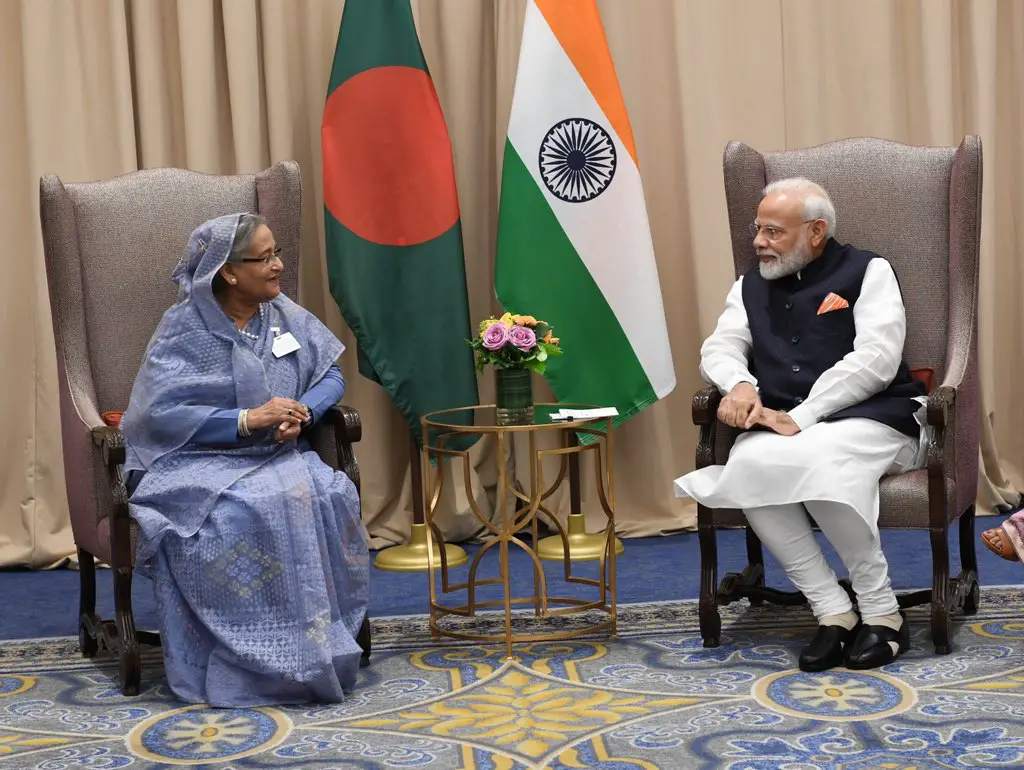Theme:
- The 130km long India-Bangladesh Friendship Pipeline (IBFPL) project, which aims to export oil from India to Bangladesh, is set to start in February 2023. The project is expected to improve long-term economic growth, strengthen relationships between India and Bangladesh, and help manage the fuel crisis currently affecting Bangladesh.
India-Bangladesh relations:
- India supported the East Pakistan Independence movement, which led to the independence of Bangladesh from Pakistan in 1971.
- India signed various treaties with Bangladesh to build relations, like the Memorandum of Understanding on Cooperation in the Peaceful Uses of Nuclear Energy (2011) to ensure the peaceful usage of nuclear power.
- Both countries have a long history of economic cooperation with each other and enjoy strong ties with each other in every field.
- India shares a 4096 km long land border with Bangladesh, which is the 5TH largest land border in the world.
- Bangladesh is located directly to the south of India’s Siliguri Corridor, which connects the northeastern states with India. This corridor is also known as the “Chicken’s Neck” due to its being just 27 km wide, which becomes an easy choke point that China can take advantage of. Bangladesh provides India with an alternative route for trade and commerce with the northeastern states.
- Bangladesh is an important partner for maintaining security and stability in the region, particularly in the fight against terrorism.
- This security cooperation is also important for Bangladesh as it helps to maintain stability and security in the region, which is crucial for Bangladesh’s economic growth and development.
- India is one of the largest suppliers of energy, food, financial assistance and foreign investments to Bangladesh.
- Both countries are common members of several International Forums like the South Asian Association for Regional Cooperation (SAARC), the Bay of Bengal Initiative for Multi-Sectoral Technical and Economic Cooperation (BIMSTEC) and the Indian Ocean Rim Association for Regional Cooperation (IORA).
Challenges:
- Bangladesh’s import of Chinese military equipment including submarines in the defence sector is a major concern for India’s national security.
- There are multiple river disputes between India and Bangladesh, particularly the Ganga and Brahmaputra rivers.
- Illegal migration from Bangladesh has been a major concern for India. Also, Bangladesh does not recognize the National Register of Citizens (NRC) which contains the name of genuine Indian citizens.
- There have been several projects that India committed to making in Bangladesh but got severely delayed, which creates a lack of trust towards India and a vacuum for China to enter and increase its influence in Bangladesh.
- Bangladesh is an active partner in the Belt and Road Initiative (BRI) of China, which is a point of concern for India.
Current Development:
- India-Bangladesh trade reached $18.2 billion in 2021-22, making Bangladesh the largest trading partner of India in South Asia.
- Bangladesh is the 9th largest export destination for India.
- 50% of India’s health tourism comes from Bangladesh.
- Bangladesh also enjoys duty-free access on all tariff lines, except tobacco and alcohol, when it trades with India.
- India in collaboration with Russia is developing the first nuclear power plant in Bangladesh.
- India and Bangladesh have signed multiple power and Internet service agreements, such as the IBFPL project and Bahrampur-Bheramaram Interconnection through which India supplies 500 MW of power to Bangladesh.
- India has provided approximately $8 billion to Bangladesh over the past several years as development assistance.
- India and Bangladesh have signed many partnership agreements in major areas like the Framework of Understanding (FOU) on Cooperation in the Hydrocarbon Sector, to enhance cooperation in the hydrocarbon sector.
Way Forward:
- Bangladesh is said to enter the Developing Countries list by 2026, from the current Less Developed Country (LDC) status. This will end the benefits received from WTO for LDC status. This will give an opportunity to India to increase its economic ties with Bangladesh.
- India and Bangladesh signed the Comprehensive Economic Partnership Agreement (CEPA) in 2011 which goes beyond traditional Free Trade Agreements (FTAs) and increases cooperation in multiple sectors. The problem is that both countries have not yet fully implemented this agreement. India should focus on its full implementation as soon as possible.
- Both countries should work together to resolve the multiple disputes that both have through diplomatic talks and negotiations.
- India and Bangladesh need to work together to complete the existing pending projects and to build more new projects to improve the connectivity, trade and tourism between both countries.
Conclusion:
India and Bangladesh have traditionally had a strong relationship, based on cultural, historical, and economic ties. India and Bangladesh have been working to increase trade and investment between the two countries, and there is still significant potential for further growth. Through sustained effort and cooperation from both sides, there is significant potential for the two countries to continue to strengthen their relationship and promote economic development in the region.
Your Turn…
What’s your take on this topic? Express your point of view through the comment section below. And subscribe to our blog to read answers to the trending GD topics.
Copyright @ Group Discussion Ideas.

